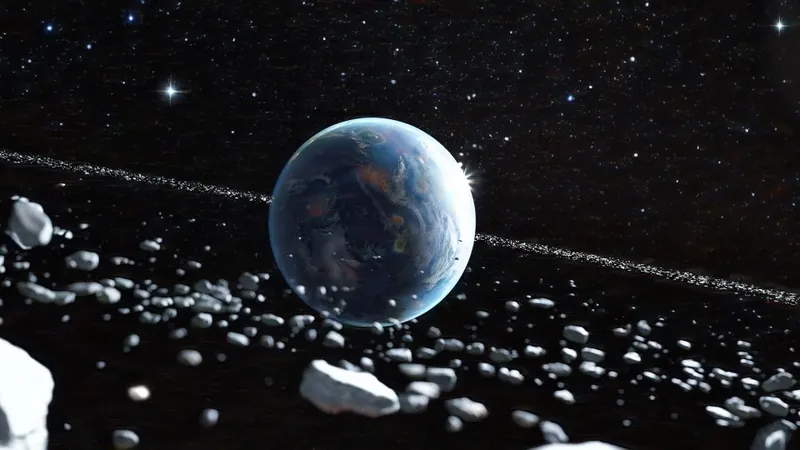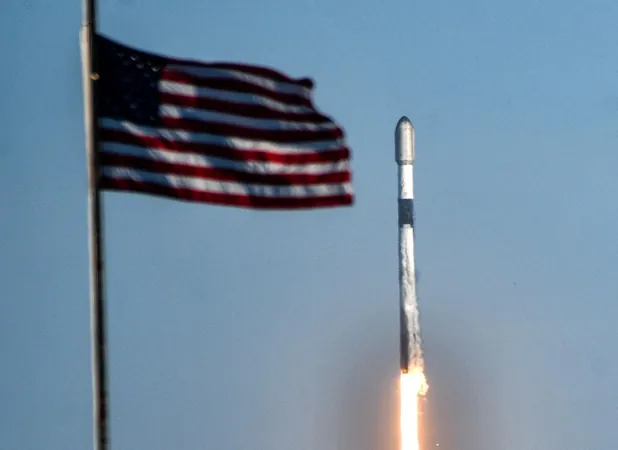
Could Earth Have Had a Ring? New Research Proposes a Stunning Theory About an Ancient Climate Event
2024-11-18
Author: Yan
Could Earth Have Had a Ring?
In a groundbreaking new study, scientists are suggesting that Earth may have once had its own ring system around 466 million years ago, similar to the famous rings of Saturn. This intriguing hypothesis, put forth in a paper published in the journal Earth and Planetary Science Letters, could explain a mysterious spike in meteorite impacts and a historic global climate freeze during the Ordovician Period.
Meteorite Impacts and Earth’s Ancient Climate
During this critical period of Earth’s history, the planet experienced one of its most active phases in terms of meteorite collisions. The research highlights that nearly two dozen impact craters have been found clustered within 30 degrees of the equator, an unusual distribution that leads researchers to believe that these meteoroids might have originated from a rocky ring encircling early Earth.
Andrew Tomkins, a geologist and professor at Monash University in Melbourne, Australia, emphasized the statistical improbability of finding 21 craters so close to the equator if these impacts were random. He points out that they should be scattered more evenly across the planet's surface, similar to the distribution of craters on the moon.
The Hirnantian Age and Global Climate Freeze
The new findings not only address why there's a spike in impacts during the Ordovician Period but also propose a thrilling answer to the cause behind one of the coldest climate events in Earth's history: a global deep freeze, possibly triggered by the shadow cast by an ancient ring. This period, known as the Hirnantian Age, marked a significant drop in global temperatures that reshaped life on the planet.
Asteroid’s Role in the Hypothesis
The theory suggests that a large asteroid, measuring about 7.5 miles (12 kilometers) in diameter, approached Earth and entered its Roche limit—an area where Earth’s gravitational forces are strong enough to tear apart a celestial body. Instead of creating random impacts across the planet, the resulting debris formed a ring around Earth. This process is somewhat akin to how the rings of Saturn are thought to have formed from the debris of its icy moons.
Supporting Evidence for the Theory
To bolster their hypothesis, the study’s authors conducted a meticulous investigation into historical impact data and geological records. They discovered that Earth has about 200 known impact strikes throughout its history, and the concentration of craters from the Ordovician is particularly telling. Only a fraction of Earth's land surface near the equator is suited to preserve craters, further supporting the idea that these impacts stemmed from a ring, as opposed to random chance.
The research also references a previous study indicating that signs of the Ordovician impact spike exist only on Earth, adding another layer of credibility to their claims. Additionally, geological deposits from that era showed elevated levels of specific meteorite materials, which indicated that a large space-weathered asteroid had entered Earth's Roche limit, supporting the ring theory.
Implications for Earth’s History and Evolution of Life
The implications of this theory are staggering. If Earth once bore a ring, it could have influenced the evolution of life during a period marked by monumental climatic shifts. Understanding the dynamics of such ancient rings could even shed light on contemporary climate change and the history of life on our planet, as Tomkins articulates that insight into past climate events helps inform our understanding of life's evolution.
Other Celestial Bodies
In a curious twist, researchers suggest that scenarios involving planetary rings are not exclusive to Earth. Mars may have had rings in its past and could potentially develop a new ring system as its moon Phobos spirals downward due to gravitational forces.
Conclusion: Future Investigations
Meanwhile, modern observers are captivated by an asteroid named 2024 PT5, which passes near Earth—affectionately dubbed a "mini-moon." Despite its close orbit, this asteroid does not pose any threat of forming a new ring around our planet.
As scientists continue to explore these ancient phenomena, the allure of Earth’s potential ring system invites further investigation. The possibility of a ring around our planet opens exciting avenues for understanding Earth’s complex history, the evolution of life, and even hints at what may lie in store for the other celestial bodies in our solar system. The universe continues to surprise us, and with each discovery, we uncover the incredible story of our cosmic lineage.


 Brasil (PT)
Brasil (PT)
 Canada (EN)
Canada (EN)
 Chile (ES)
Chile (ES)
 España (ES)
España (ES)
 France (FR)
France (FR)
 Hong Kong (EN)
Hong Kong (EN)
 Italia (IT)
Italia (IT)
 日本 (JA)
日本 (JA)
 Magyarország (HU)
Magyarország (HU)
 Norge (NO)
Norge (NO)
 Polska (PL)
Polska (PL)
 Schweiz (DE)
Schweiz (DE)
 Singapore (EN)
Singapore (EN)
 Sverige (SV)
Sverige (SV)
 Suomi (FI)
Suomi (FI)
 Türkiye (TR)
Türkiye (TR)